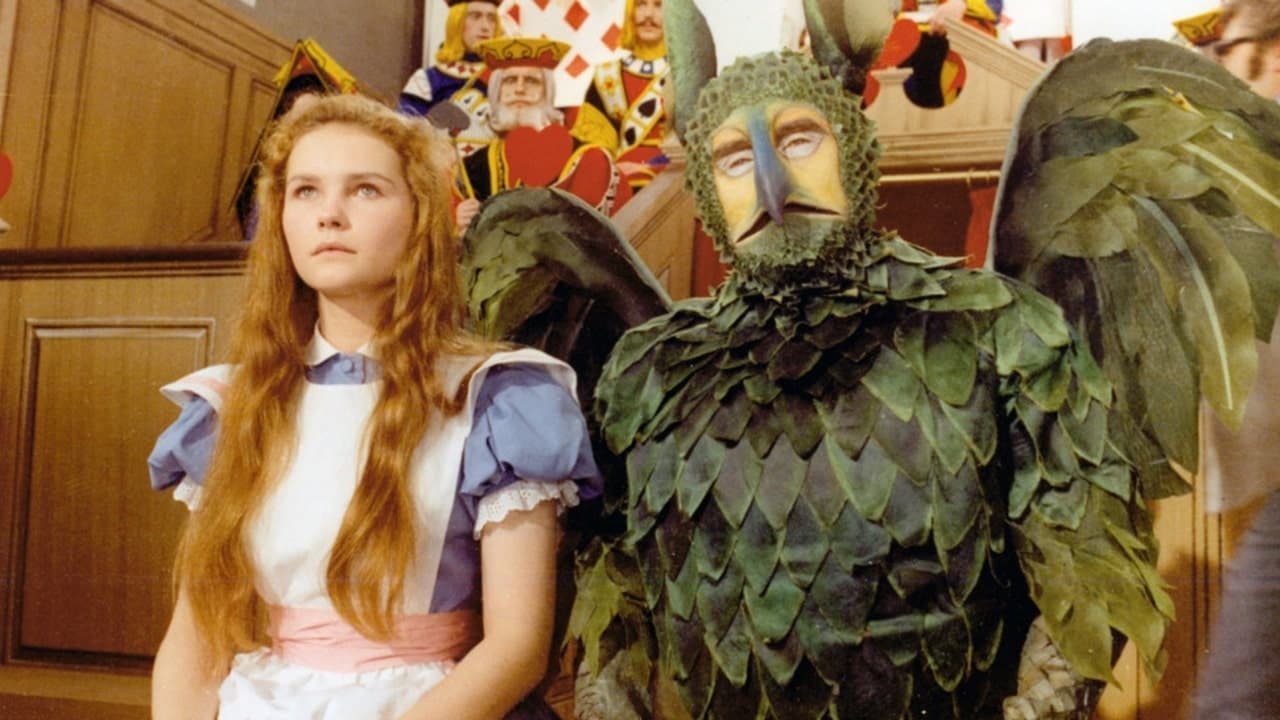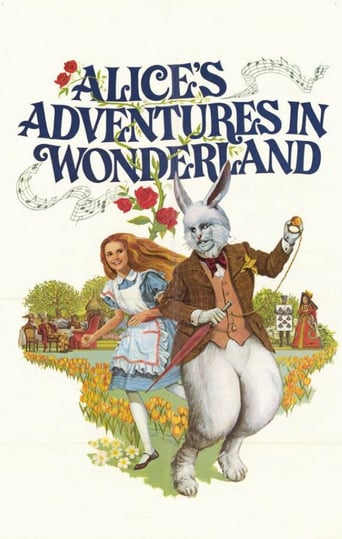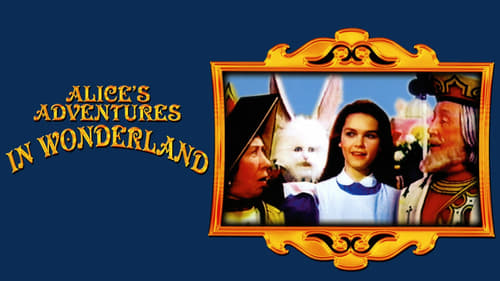




Really Surprised!
It was OK. I don't see why everyone loves it so much. It wasn't very smart or deep or well-directed.
View MoreEasily the biggest piece of Right wing non sense propaganda I ever saw.
View MoreGreat example of an old-fashioned, pure-at-heart escapist event movie that doesn't pretend to be anything that it's not and has boat loads of fun being its own ludicrous self.
View MoreWas this movie really planned out in advance? Or did they just put some of the biggest names of British cinema in front of a movie camera and tell them they had a fortnight to come up with something to amuse the kids?"Alice's Adventures In Wonderland" is a slapdash mishmosh based on one of the most popular children's classics. The result is something Lewis Carroll may have found curiouser and curiouser, a musical without tunes, a dancing show without apparent choreography, a comedy without laughs, and a high-blown fantasy where sets and costumes seem plucked from a community-theater pantomime.Two of the biggest stars involved were working behind the camera, and apparently with different scripts. Legendary cinematographer Geoffrey Unsworth won a British Oscar for this, though his gauzy lenswork fails to disguise the gimcrack artificiality of some remarkably cheap sets. John Barry was a great movie composer here composing his only movie musical, so why are his songs so non-distinctive and at odds in their fussy seriousness with everything else this film is about?Everything about this film is tonally off, beginning with a sequence showing young Alice (Fiona Fullerton) being rowed by a leering Carroll and his effete friend (Hywel Bennett is the first-billed cast member despite just being on screen for less than two minutes and never saying a line). Freudian, sexual undertones seem in play, but then suddenly Alice is chasing Michael Crawford in a giant bunny costume while offering dainty narration for the slower viewers."Goodness, I'm falling! Wh- What's going to happen to me now?"Like it or not, Fullerton carries on like this for the rest of the picture, cueing her audience for their expected reactions. When greeted by a bunch of actors bouncing around in giant costumes, which happens every five minutes or so, she covers her mouth and giggles. When she objects to having her head ordered cut off by the Queen of Hearts (Flora Robson), she folds her arms and looks mad. All this childishness seems rather odd given Fullerton's old enough to practically bust out of her crinolines, which at least gives the Daddies in the audience something to root for.My main reason for watching this film was to see Peter Sellers working through the middle of his early-1970s dry period. The film makes decent use of him as the March Hare, mingling with Alice, the Mad Hatter (Robert Helpmann), and the Dormouse (Dudley Moore) in the film's one well-sustained sequence. Sellers seems to have fun playing his part with eye-rolling excess."Where was the Magna Carta signed?" he asks Alice.I don't know, she answers."At the bottom!"Logic is kind of by-the-by with the Alice books by design, but you need some of it to make a movie, even one set in Wonderland. Sequences come and go too quickly, with no apparent stopping point. The movie seems to have been edited with garden shears.Writer-director William Sterling only directed for cinema this one time, and the production seems to have gotten away from him somewhere close to its inception. How does one cast a film with so many names (Ralph Richardson, Michael Hordern, Peter Bull, and Dennis Price are also on hand), then cover their faces and/or have them romp around in dance productions so strenuous they require doubles?To make a film of this material, you need a strong hand somewhere near the center of things, not just talent around the edges. "Alice's Adventures" is not even that interesting as a flop.
View MoreThis is the fourth film version I’ve watched of Lewis Carroll’s classic – the 1903 Silent, the 1951 Walt Disney animated version, and the 1966 British TV adaptation; there are at least three more adaptations I’m interested in – Paramount’s 1933 all-star feature, the 1949 Franco-British version mixing live-action with puppet figures, and Jan Svankmajer’s 1988 film. This musicalized version was made in a time when setting literary classics (everything from Miguel Cervantes to George Bernard Shaw, Charles Dickens to James Hilton) to music was quite fashionable. Still, despite the engagement of a tremendous cast – Michael Jayston, Hywel Bennett, Michael Crawford, Ralph Richardson, Peter Bull, Roy Kinnear, Robert Helpmann, Peter Sellers, Dudley Moore, Dennis Price, Flora Robson, Spike Milligan, Michael Hordern – they are mostly ineffective and even unrecognizable under all the heavy make-up! Alice herself – Fiona Fullerton – isn’t very sympathetic either.The highlight is perhaps the tea party sequence with Helpmann (as The Mad Hatter), Sellers (as The March Hare) and Moore (as The Dormouse) – after which the slow-moving film starts slipping into boredom. The music by John Barry and lyrics by Don Black are decent at best, but distinctly unmemorable. Writer-director William Sterling’s adaptation – whose only film in that capacity this was – is disappointingly uninspired, then, turning Carroll’s surrealistic original into a dullish kiddie film! Apart from the opportunity of star-spotting, the film’s main virtues, therefore, are Geoffrey Unsworth’s cinematography and Anthony Mendelsohn’s colorful costume designs – qualities which were also recognized by the BAFTA. Admittedly, I rewatched this via a budget DVD release of a public domain, panned-and-scanned and extremely hazy print – which certainly didn’t aid my appreciation of it in any way!
View MoreThis version follows the classic story faithfully, if a bit unimaginatively. As the original is itself somewhat loose structurally, it makes any film version inevitably seem rambling. I know of no cinematic version of Alice in Wonderland that completely successfully overcomes this. This 1972 is usual in that respect. The set design is perhaps too closely modelled on the original Alice drawings, and as such, it is colourful and lavish although it looks rather dated and stagy by modern standards. One major drawback (which seems consistent with all the other Alice films) is that the songs are completely forgettable. A very youthful Fiona Fullerton is convincing as Alice, and a fun aspect of the film is to guess the identities of the heavily made-up cast of well-known actors, some of whom are more easily guessable than others.
View MoreA book which details the strange adventures of a young girl in a surreal dreamworld is perhaps not a natural subject for a film, but Lewis Carroll's classic has been filmed many times. Few if any, however, of those filmed versions have themselves achieved classic status. The one exception is possibly Disney's cartoon version; this live-action British version from the early 1970s is less well known but is, I think, superior.Unlike the Disney version, this film stays faithful to Lewis Carroll's original text, except in one respect. Carroll probably envisaged Alice as a little girl (although her exact age is not given in the book, and Tenniel's famous illustrations show a strange child-woman with a twenty-year-old head on ten-year-old shoulders). In this film, however, Alice is not a child but a beautiful teenager on the verge of womanhood. Although purists may not approve of this change, in my view it actually strengthens the film, in two ways. The first is that Fiona Fullerton makes an enchanting Alice and brings a wonderful sense of freshness and innocence to the role. Paradoxically, she seems more child-like than would many child-actors, whose stock-in-trade is often a brash knowingness and the ability to seem old beyond their years. The second reason why the film works better with an older Alice is that it attempts to explore the psychological sub-texts of the original novel in a way that the Disney version, for example, did not. The story has a deeper significance than that of merely an entertaining children's story. Alice's bizarre adventures are symbolic of the process of discovery of oneself and of the wider world which constitutes growing up. No doubt amateur Freudians could have great fun interpreting the various incidents, but it is not my purpose here to comment on these interpretations. It is enough to say that Alice must, as must we all, try to make sense of a world which often seems strange and bewildering. Her world is simply a bit stranger than everyone else's is. Given that adolescence is for many of us a difficult, disorientating period, an Alice who is on the border between childhood and adulthood seems entirely appropriate. The title of the film's best-known song, `The Me I Never Knew', strengthens the idea that the book is about the attainment of self-knowledge.Miss Fullerton is ably assisted by a splendid supporting cast, including some of the best-known British comedians of the period (Peter Sellers, Dudley Moore, Michael Crawford, Spike Milligan, Roy Kinnear) and some actors better known for more serious roles (Ralph Richardson, Michael Hordern). Perhaps the cost of employing so many well-known names emptied the budget, as the sets look rather cheap and crudely made. That, however, is not a serious criticism; indeed, one could even say that the unreal-looking sets contribute to the strange, dreamlike feel of this film. In a surrealist film, realism is not a virtue. 8/10.
View More